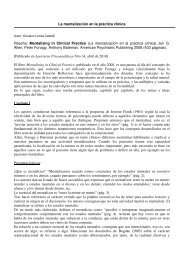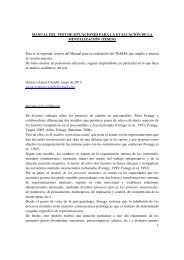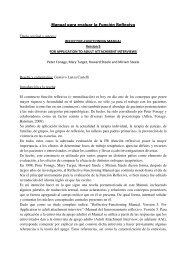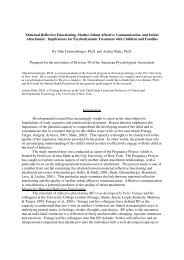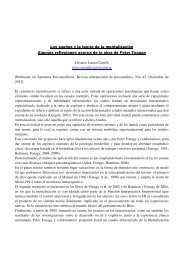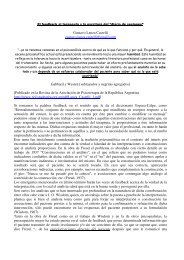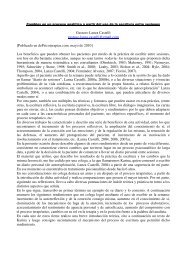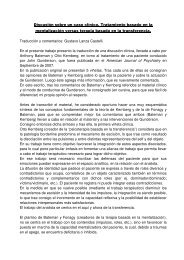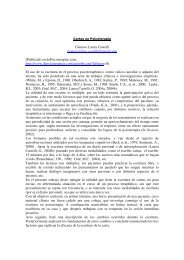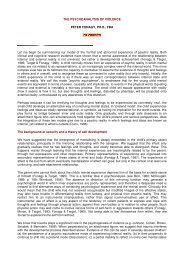Mentalization, Mental States and Affect Elaboration - mentalizacion y ...
Mentalization, Mental States and Affect Elaboration - mentalizacion y ...
Mentalization, Mental States and Affect Elaboration - mentalizacion y ...
You also want an ePaper? Increase the reach of your titles
YUMPU automatically turns print PDFs into web optimized ePapers that Google loves.
Would imply something intermediate between "traces of the PP are present" <strong>and</strong> next<br />
step on the scale, which implies that a definite exemplar of the PP can be identified. An<br />
incompletely developed PP, or an unclear or atypical PP is also to be rated as "2".<br />
3<br />
Implies that two conditions are met:<br />
1. that a definite "exemplar", or "case" of the PP is documented in the material (e.g.<br />
a clear defensive activity is present; mental states are formulated <strong>and</strong><br />
acknowledged; a clearly identifiable interpersonal conflictual expression is seen,<br />
etc).<br />
2. But that in relation to the complete segment, section of the material, the PP never<br />
fully predominates the picture. That although present to a clear <strong>and</strong> significant<br />
degree, the PP does not "organize" the more significant aspect of the material.<br />
4<br />
Would imply something intermediate between "a definite exemplar or case" <strong>and</strong> the next<br />
step (i.e. a 5 rating) on the scale, which involves in addition that the material under<br />
consideration is typical of the PP, that the PP organises the subject's mental state. A 4<br />
rating is obtained when the "exemplar" or "token" does not perfectly illustrate the PP or<br />
"type". Or when the case seems mixed, atypical or unevenly distributed within the<br />
segment, but when nevertheless the PP is strong d by the material. The case can be<br />
mixed, atypical or unevenly distributed, as when some other PP is intermixed with the<br />
one being considered (e.g. some defensive mixed in an overall reflective criterion or PP).<br />
5 = Completely descriptive<br />
Which means that the psychic phenomenon (PP) described or referred to by the MSRS<br />
specific criterion is either present throughout the material, or if unevenly present, that it<br />
predominates <strong>and</strong> can be said to both latently <strong>and</strong> manifestly influence <strong>and</strong> structure the<br />
material.<br />
References<br />
Bouchard, M. A., Audet, C., Picard, C., Carrier, M. & Milcent, M.P. (2001). The <strong>Mental</strong><br />
<strong>States</strong> Rating System. Scoring Manual. Unpublished document, Université de Montréal,<br />
Montréal, Canada.<br />
Bouchard, M.A. Audet, St-Am<strong>and</strong>, P., Perry, J.C., Picard, C., & Wiethaeuper, D. (1999).<br />
Psychoanalytic Process: The Montreal Transference Countertransference Measure.<br />
Psychoanalytic Process Research Strategies II. 20 th Ulm Workshop of Empirical<br />
Research in Psychoanalysis. Kächele, H., Mergenthaler, E. & Krause, R. (Eds.). CD-<br />
ROM. University of Ulm.<br />
Bouchard, M.A., Norm<strong>and</strong>in, L.,& Séguin, M.H. (1995). Countertransference as obstacle<br />
<strong>and</strong> instrument: a comprehensive <strong>and</strong> descriptive framework. Psychoanalytic Quarterly,<br />
LXIV, 617-645.



